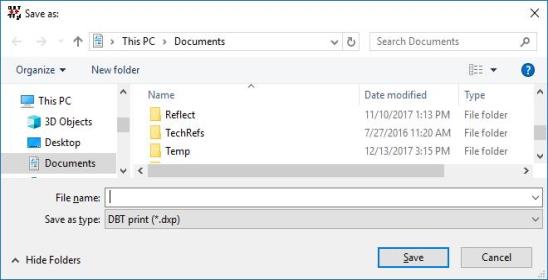File: Save as
Keystroke: F3

This is a standard
It allows you to save your file under a different name and/or in a different location or format.
File Name: is the text entry field where you enter the (possibly new) name of your document to save it.
Save As also allows you to save your files in an alternative format as explained below. This can be useful if you wish to access the files with a program or device other than DBT.
Note: It is not advisable to simply change the file extension in the
Saving "Print" documents
The dialog presents you with a drop down list of file formats as shown below. (See below for saving braille documents).

- DBT print (*.dxp) - Saves as a current DBT inkprint file.
- DBT print, v10.5 and earlier (*.dxp) - saves your document in a pre-10.6 format. If you do this, note that any DBT Codes used which were introduced into DBT from version 10.6 or above will be ignored, and may indeed produce unexpected results if translated or embossed in earlier versions.
- Formatted text, IBM ASCII (*.prf) - saves the file (without embedded DBT commands) using the MS-DOS-437 character set.
- Formatted text, Windows ANSI (*.prf) - saves the file (without embedded DBT commands) using the Windows-1252 character set.
- Duxbury coded text (*.txt) - saves as a text file containing embedded DBT Codes (obsolete).
- HTML (*.htm) - saves as an HTML file (which can be read in a web browser).
- SGML/ICADD/HTML Legacy (*.sgm) - saves as a tagged file in which the DBT codes are placed inside angle brackets (obsolete).
- LaTeX (*.tex) - saves as a TeX format file which can be opened in appropriate math editing software.
- Word Document (*.docx) - saves as a Word file. This format requires MS Word 2007 or above installed on your computer.
Saving Braille documents
The dialog presents the following drop down list for braille documents.

-
DBT braille (*.dxb) - saves the document as a current DBT braille file.
-
DBT Braille, v10.5 and earlier (*.dxb) - saves the document in a pre-10.6 format. If you do this, note that any DBT Codes used which were introduced into DBT from version 10.6 or above will be ignored, and may indeed produce unexpected results if translated or embossed in earlier versions.
-
Formatted braille, USA encoding (*.brf) - saves the file in the USA braille encoding (potentially different from your currently selected braille encoding).
-
Formatted braille, local encoding (*.brf) - saves the file in the currently selected braille encoding (as selected in the Global Menu: Internationalization dialogue).
-
Duxbury coded braille (*.bru) - saves as a text file containing embedded DBT Codes (obsolete).
-
Refreshable braille (*.lbf) - reformats and saves the document in the linear braille format (including embedded "dollar codes") for a refreshable braille device.